Xu Shen
BlindGuard: Safeguarding LLM-based Multi-Agent Systems under Unknown Attacks
Aug 11, 2025Abstract:The security of LLM-based multi-agent systems (MAS) is critically threatened by propagation vulnerability, where malicious agents can distort collective decision-making through inter-agent message interactions. While existing supervised defense methods demonstrate promising performance, they may be impractical in real-world scenarios due to their heavy reliance on labeled malicious agents to train a supervised malicious detection model. To enable practical and generalizable MAS defenses, in this paper, we propose BlindGuard, an unsupervised defense method that learns without requiring any attack-specific labels or prior knowledge of malicious behaviors. To this end, we establish a hierarchical agent encoder to capture individual, neighborhood, and global interaction patterns of each agent, providing a comprehensive understanding for malicious agent detection. Meanwhile, we design a corruption-guided detector that consists of directional noise injection and contrastive learning, allowing effective detection model training solely on normal agent behaviors. Extensive experiments show that BlindGuard effectively detects diverse attack types (i.e., prompt injection, memory poisoning, and tool attack) across MAS with various communication patterns while maintaining superior generalizability compared to supervised baselines. The code is available at: https://github.com/MR9812/BlindGuard.
Understanding the Information Propagation Effects of Communication Topologies in LLM-based Multi-Agent Systems
May 29, 2025Abstract:The communication topology in large language model-based multi-agent systems fundamentally governs inter-agent collaboration patterns, critically shaping both the efficiency and effectiveness of collective decision-making. While recent studies for communication topology automated design tend to construct sparse structures for efficiency, they often overlook why and when sparse and dense topologies help or hinder collaboration. In this paper, we present a causal framework to analyze how agent outputs, whether correct or erroneous, propagate under topologies with varying sparsity. Our empirical studies reveal that moderately sparse topologies, which effectively suppress error propagation while preserving beneficial information diffusion, typically achieve optimal task performance. Guided by this insight, we propose a novel topology design approach, EIB-leanrner, that balances error suppression and beneficial information propagation by fusing connectivity patterns from both dense and sparse graphs. Extensive experiments show the superior effectiveness, communication cost, and robustness of EIB-leanrner.
SpecOffload: Unlocking Latent GPU Capacity for LLM Inference on Resource-Constrained Devices
May 15, 2025Abstract:Efficient LLM inference on resource-constrained devices presents significant challenges in compute and memory utilization. Due to limited GPU memory, existing systems offload model weights to CPU memory, incurring substantial I/O overhead between the CPU and GPU. This leads to two major inefficiencies: (1) GPU cores are underutilized, often remaining idle while waiting for data to be loaded; and (2) GPU memory has low impact on performance, as reducing its capacity has minimal effect on overall throughput.In this paper, we propose SpecOffload, a high-throughput inference engine that embeds speculative decoding into offloading. Our key idea is to unlock latent GPU resources for storing and executing a draft model used for speculative decoding, thus accelerating inference at near-zero additional cost. To support this, we carefully orchestrate the interleaved execution of target and draft models in speculative decoding within the offloading pipeline, and propose a planner to manage tensor placement and select optimal parameters. Compared to the best baseline, SpecOffload improves GPU core utilization by 4.49x and boosts inference throughput by 2.54x. Our code is available at https://github.com/MobiSense/SpecOffload .
Harnessing LLMs Explanations to Boost Surrogate Models in Tabular Data Classification
May 09, 2025Abstract:Large Language Models (LLMs) have shown remarkable ability in solving complex tasks, making them a promising tool for enhancing tabular learning. However, existing LLM-based methods suffer from high resource requirements, suboptimal demonstration selection, and limited interpretability, which largely hinder their prediction performance and application in the real world. To overcome these problems, we propose a novel in-context learning framework for tabular prediction. The core idea is to leverage the explanations generated by LLMs to guide a smaller, locally deployable Surrogate Language Model (SLM) to make interpretable tabular predictions. Specifically, our framework mainly involves three stages: (i) Post Hoc Explanation Generation, where LLMs are utilized to generate explanations for question-answer pairs in candidate demonstrations, providing insights into the reasoning behind the answer. (ii) Post Hoc Explanation-Guided Demonstrations Selection, which utilizes explanations generated by LLMs to guide the process of demonstration selection from candidate demonstrations. (iii) Post Hoc Explanation-Guided Interpretable SLM Prediction, which utilizes the demonstrations obtained in step (ii) as in-context and merges corresponding explanations as rationales to improve the performance of SLM and guide the model to generate interpretable outputs. Experimental results highlight the framework's effectiveness, with an average accuracy improvement of 5.31% across various tabular datasets in diverse domains.
Latte: Transfering LLMs` Latent-level Knowledge for Few-shot Tabular Learning
May 08, 2025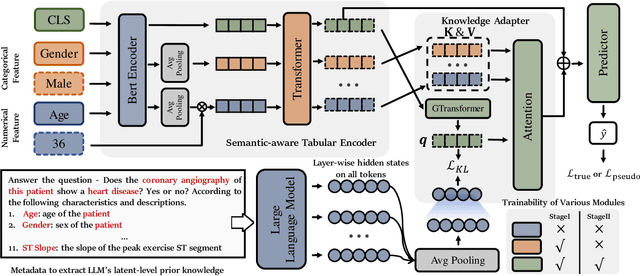
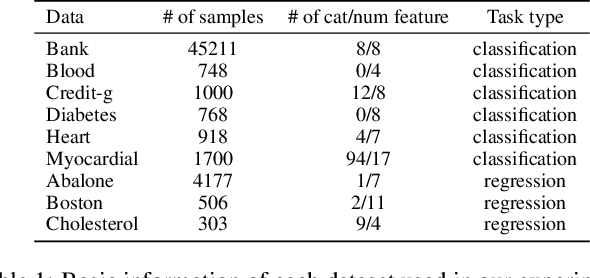
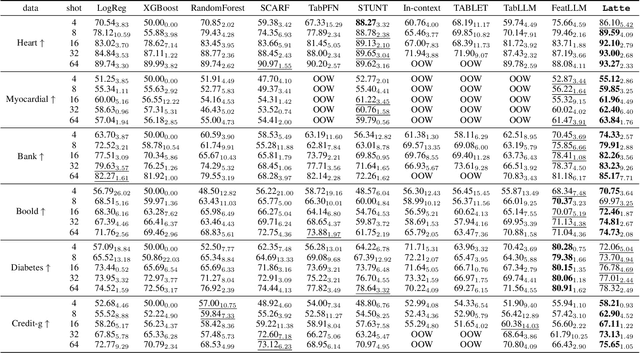

Abstract:Few-shot tabular learning, in which machine learning models are trained with a limited amount of labeled data, provides a cost-effective approach to addressing real-world challenges. The advent of Large Language Models (LLMs) has sparked interest in leveraging their pre-trained knowledge for few-shot tabular learning. Despite promising results, existing approaches either rely on test-time knowledge extraction, which introduces undesirable latency, or text-level knowledge, which leads to unreliable feature engineering. To overcome these limitations, we propose Latte, a training-time knowledge extraction framework that transfers the latent prior knowledge within LLMs to optimize a more generalized downstream model. Latte enables general knowledge-guided downstream tabular learning, facilitating the weighted fusion of information across different feature values while reducing the risk of overfitting to limited labeled data. Furthermore, Latte is compatible with existing unsupervised pre-training paradigms and effectively utilizes available unlabeled samples to overcome the performance limitations imposed by an extremely small labeled dataset. Extensive experiments on various few-shot tabular learning benchmarks demonstrate the superior performance of Latte, establishing it as a state-of-the-art approach in this domain
A Comprehensive Survey of Synthetic Tabular Data Generation
Apr 23, 2025Abstract:Tabular data remains one of the most prevalent and critical data formats across diverse real-world applications. However, its effective use in machine learning (ML) is often constrained by challenges such as data scarcity, privacy concerns, and class imbalance. Synthetic data generation has emerged as a promising solution, leveraging generative models to learn the distribution of real datasets and produce high-fidelity, privacy-preserving samples. Various generative paradigms have been explored, including energy-based models (EBMs), variational autoencoders (VAEs), generative adversarial networks (GANs), large language models (LLMs), and diffusion models. While several surveys have investigated synthetic tabular data generation, most focus on narrow subdomains or specific generative methods, such as GANs, diffusion models, or privacy-preserving techniques. This limited scope often results in fragmented insights, lacking a comprehensive synthesis that bridges diverse approaches. In particular, recent advances driven by LLMs and diffusion-based models remain underexplored. This gap hinders a holistic understanding of the field`s evolution, methodological interplay, and open challenges. To address this, our survey provides a unified and systematic review of synthetic tabular data generation. Our contributions are threefold: (1) we propose a comprehensive taxonomy that organizes existing methods into traditional approaches, diffusion-based methods, and LLM-based models, and provide an in-depth comparative analysis; (2) we detail the complete pipeline for synthetic tabular data generation, including data synthesis, post-processing, and evaluation; (3) we identify major challenges, explore real-world applications, and outline open research questions and future directions to guide future work in this rapidly evolving area.
Leveraging Submodule Linearity Enhances Task Arithmetic Performance in LLMs
Apr 15, 2025



Abstract:Task arithmetic is a straightforward yet highly effective strategy for model merging, enabling the resultant model to exhibit multi-task capabilities. Recent research indicates that models demonstrating linearity enhance the performance of task arithmetic. In contrast to existing methods that rely on the global linearization of the model, we argue that this linearity already exists within the model's submodules. In particular, we present a statistical analysis and show that submodules (e.g., layers, self-attentions, and MLPs) exhibit significantly higher linearity than the overall model. Based on these findings, we propose an innovative model merging strategy that independently merges these submodules. Especially, we derive a closed-form solution for optimal merging weights grounded in the linear properties of these submodules. Experimental results demonstrate that our method consistently outperforms the standard task arithmetic approach and other established baselines across different model scales and various tasks. This result highlights the benefits of leveraging the linearity of submodules and provides a new perspective for exploring solutions for effective and practical multi-task model merging.
Mamba-Based Graph Convolutional Networks: Tackling Over-smoothing with Selective State Space
Jan 26, 2025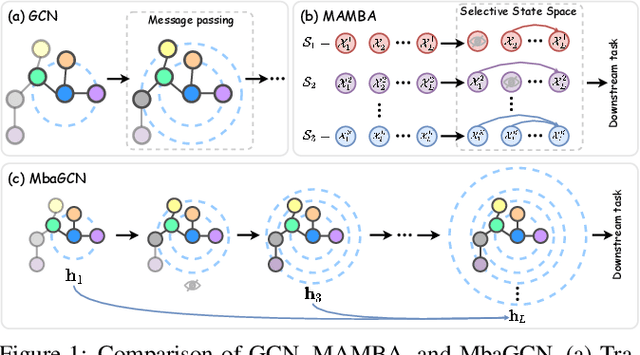



Abstract:Graph Neural Networks (GNNs) have shown great success in various graph-based learning tasks. However, it often faces the issue of over-smoothing as the model depth increases, which causes all node representations to converge to a single value and become indistinguishable. This issue stems from the inherent limitations of GNNs, which struggle to distinguish the importance of information from different neighborhoods. In this paper, we introduce MbaGCN, a novel graph convolutional architecture that draws inspiration from the Mamba paradigm-originally designed for sequence modeling. MbaGCN presents a new backbone for GNNs, consisting of three key components: the Message Aggregation Layer, the Selective State Space Transition Layer, and the Node State Prediction Layer. These components work in tandem to adaptively aggregate neighborhood information, providing greater flexibility and scalability for deep GNN models. While MbaGCN may not consistently outperform all existing methods on each dataset, it provides a foundational framework that demonstrates the effective integration of the Mamba paradigm into graph representation learning. Through extensive experiments on benchmark datasets, we demonstrate that MbaGCN paves the way for future advancements in graph neural network research.
Enhancing Multiple Dimensions of Trustworthiness in LLMs via Sparse Activation Control
Nov 04, 2024



Abstract:As the development and application of Large Language Models (LLMs) continue to advance rapidly, enhancing their trustworthiness and aligning them with human preferences has become a critical area of research. Traditional methods rely heavily on extensive data for Reinforcement Learning from Human Feedback (RLHF), but representation engineering offers a new, training-free approach. This technique leverages semantic features to control the representation of LLM's intermediate hidden states, enabling the model to meet specific requirements such as increased honesty or heightened safety awareness. However, a significant challenge arises when attempting to fulfill multiple requirements simultaneously. It proves difficult to encode various semantic contents, like honesty and safety, into a singular semantic feature, restricting its practicality. In this work, we address this issue through ``Sparse Activation Control''. By delving into the intrinsic mechanisms of LLMs, we manage to identify and pinpoint components that are closely related to specific tasks within the model, i.e., attention heads. These heads display sparse characteristics that allow for near-independent control over different tasks. Our experiments, conducted on the open-source Llama series models, have yielded encouraging results. The models were able to align with human preferences on issues of safety, factuality, and bias concurrently.
Interpreting and Improving Large Language Models in Arithmetic Calculation
Sep 03, 2024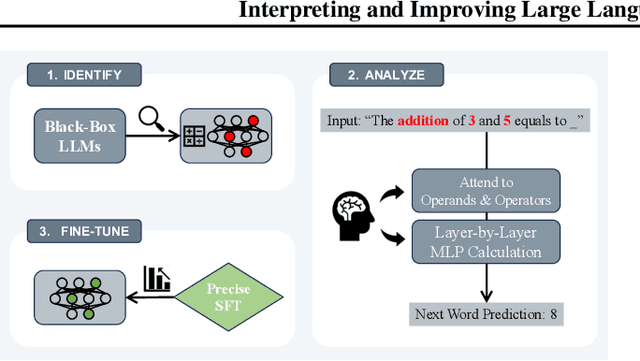

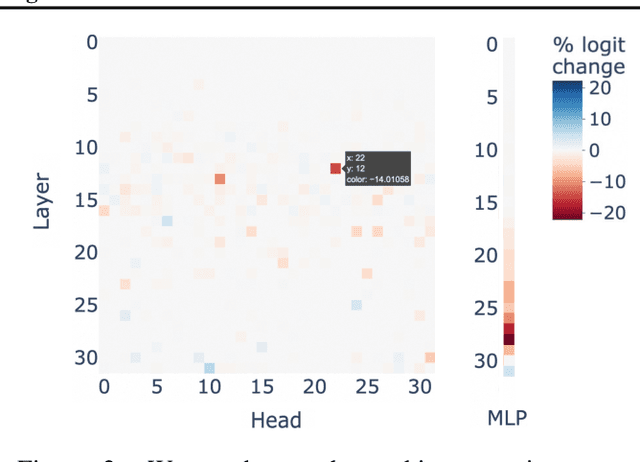
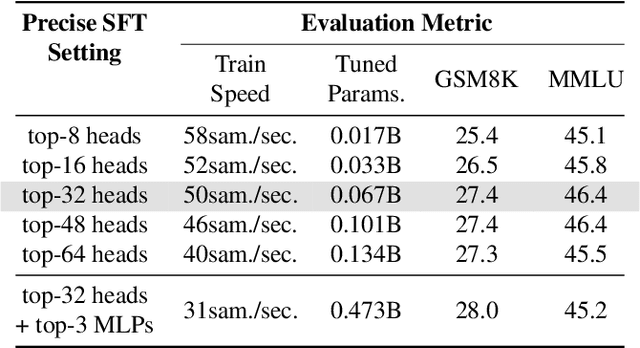
Abstract:Large language models (LLMs) have demonstrated remarkable potential across numerous applications and have shown an emergent ability to tackle complex reasoning tasks, such as mathematical computations. However, even for the simplest arithmetic calculations, the intrinsic mechanisms behind LLMs remain mysterious, making it challenging to ensure reliability. In this work, we delve into uncovering a specific mechanism by which LLMs execute calculations. Through comprehensive experiments, we find that LLMs frequently involve a small fraction (< 5%) of attention heads, which play a pivotal role in focusing on operands and operators during calculation processes. Subsequently, the information from these operands is processed through multi-layer perceptrons (MLPs), progressively leading to the final solution. These pivotal heads/MLPs, though identified on a specific dataset, exhibit transferability across different datasets and even distinct tasks. This insight prompted us to investigate the potential benefits of selectively fine-tuning these essential heads/MLPs to boost the LLMs' computational performance. We empirically find that such precise tuning can yield notable enhancements on mathematical prowess, without compromising the performance on non-mathematical tasks. Our work serves as a preliminary exploration into the arithmetic calculation abilities inherent in LLMs, laying a solid foundation to reveal more intricate mathematical tasks.
 Add to Chrome
Add to Chrome Add to Firefox
Add to Firefox Add to Edge
Add to Edge